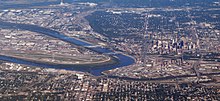West Bottoms
This article needs additional citations for verification. (May 2020) |

The West Bottoms is an industrial area immediately to the west of downtown Kansas City, Missouri. Located in Kansas City, Missouri and Kansas City, Kansas it sits at the confluence of the Missouri River and the Kansas River. The area is one of the oldest areas of the cities.
While the West Bottoms is still home to several industrial buildings today, its antique shops and haunted houses are very popular.[1] Additionally, there are several art galleries and restaurants located in the West Bottoms, and a few companies have offices in the area.
History[]
Kansas City's first Union Depot was located here. It was home to the Kansas City Live Stock Exchange and Kansas City Stockyards (now defunct) prompting the huge annual American Royal livestock show at Kemper Arena, the site of the 1976 Republican National Convention.[2] Additionally, The West Bottoms was home to large industrial district which produced plows and tractors starting in the 1870s. Many of the factory buildings still stand. Some prominent examples are The Oliver Building, The Nichols and Shepard Building and The John Deere Building.
The low-lying area has been prone to floods including the Great Flood of 1951 and the Great Flood of 1993.[3]
Jim Pendergast founded the political machine here that was furthered by Tom Pendergast. Tom Pendergast was an early supporter and promoter of Harry S. Truman in Jackson County and Missouri politics.[4] Truman would later become President as Vice-President under Franklin D. Roosevelt, upon Roosevelt's death in April 1945. Jim started operations at the "Climax" Saloon on St. Louis Avenue named for a winning race horse he had bet on.
During World War II Darby Steel Corporation built most of the landing craft tanks (LCTs) that were used in various amphibious invasions. The plant built one craft a day and floated them more than 1,000 miles down the Missouri and Mississippi Rivers to New Orleans, Louisiana, prompting their "Prairie Ships" nickname. Darby's plant at the mouth of the Kansas River could hold eight 135í LCTs and 16 LCMs in various stages of construction.
Many Serbians arrived in the early 1900s and found work in the meat packing houses in the area. The Serbs founded St. George Serbian Orthodox Church on April 18, 1906. The community purchased two houses on North 1st Street. One was converted to a church and the other used as a parish home. The parish stayed in the West Bottoms until 1925 when they built a new church on Lowell Street still in Kansas City, Kansas. Today, the parish is located in Lenexa, Kansas, having built their third location in 2006.
References[]
- ^ Kelly, Dan (October 4, 2019). "Kansas City has the best haunted house in the U.S.? This KCQ shows why that's dead on". The Kansas City Star. Retrieved December 28, 2019.
- ^ Ayres, B. Drummond, Jr. (August 16, 1976). "Kemper Arena: Ordinary Inside, Unique Outside". The New York Times. Retrieved December 28, 2019.
- ^ Ziegler, Laura (July 22, 2013). "20 Years Later: A Look Back At The Floods Of 1993". KCUR-FM. Retrieved December 28, 2019.
- ^ Stillwell, Ted (December 14, 2019). "Truman worked hard, was his own man". The Neosho Daily News. Retrieved December 28, 2019.
External links[]
Coordinates: 39°06′10″N 94°36′12″W / 39.102755°N 94.603441°W
- Economy of Kansas City, Missouri
- Neighborhoods in Kansas City, Missouri
- Pendergast era
